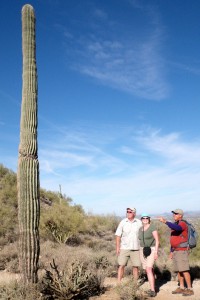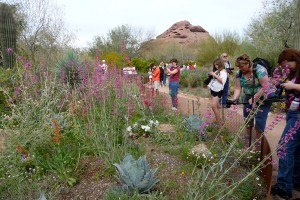 By Chris Millikan
By Chris Millikan
As first-timers to Arizona, we set out to explore the wonders of the Sonoran desert. Our investigations begin with a horseback ride just outside Scottsdale. Slapping on cowboy hats, lots of sunscreen and armed with bottles of water, we settle into our saddles aboard Gem and Big John.
Wrangler Josh leads us into the blazing afternoon sun at a leisurely pace. “This ranch was once over 17,000 hectares, stretching eastward to the McDowell Mountains and south to the Camelbacks,” he explains. It seems impossible that cattle could survive here…until told each steer had 17 hectares for grazing that included nutritious bean pods from palo verde, mesquite and other plentiful legumes.
Pointing out cacti, Josh notes, “The barrel cactus always leans southward, so locals call it compass cactus…and that fuzzy-looking golden cholla looks friendly, but wicked barbs earn it the nickname desert Velcro.” A Great Horned Owl eyes us from her nest in a stately saguaro. “She swiped that prime spot from Harris Hawks,” Josh says. “Mama owl and Ms. Hawk perched in that ironwood tree, motionless for an entire day…deciding ownership in a stare-down!” I found it interesting to learn these hawks are very social birds that hunt cooperatively. Some offspring live with their family for up to 3 years, helping raise later broods.
Cottontail rabbits and comical Gembal quail scurry into ragged underbrush. Above, untidy nest-like tangles inspire a new spin on my favourite tradition! “That’s our native mistletoe stranglin’ those trees,” Josh winks. “Y’know, I never understood kissin’ under mistletoe! It’s a parasite, suckin’ life from its hosts! And growin’ in thorn-filled palo verde, ironwood and mesquite trees, you could even get hurt smoochin’ under Arizona’s mistletoe!” Picking some tiny leaves, we roll them between our fingers and inhale the creosote shrub’s oily perfume. “After a rain, desert air smells exactly like that,” grins Josh.
Though sighting not one rattlesnake during our ride, we learn they’re pretty common, as are gopher snakes that mimic rattler behaviours to discourage predators. Josh leaves us with a sobering thought, “Remember one thing about desert life: everything wants to stick, sting, bite…or eat you! Or pretends to! Otherwise, it’s a place of rare beauty!”
 A cacophony of lively birdsong awakens us next morning for an early beat-the-heat hike in McDowell Sonoran Preserve. Trail guide Randy leads us along one of many routes in this desert mountain park. Starting up the rugged 7-kilometer loop, he advises, “Walk, don’t gawk!” Sweeping views of Scottsdale below us, vultures swooping above and surrounding desert landscapes make this difficult!
A cacophony of lively birdsong awakens us next morning for an early beat-the-heat hike in McDowell Sonoran Preserve. Trail guide Randy leads us along one of many routes in this desert mountain park. Starting up the rugged 7-kilometer loop, he advises, “Walk, don’t gawk!” Sweeping views of Scottsdale below us, vultures swooping above and surrounding desert landscapes make this difficult!
Puffing our way up to the 732-meter summit, we frequently pause to delight in purple flowers on teddy bear chollas, woodpeckers pecking nest-holes in soaring saguaros and fiery red blossoms on the ocotillo’s whip-like branches. Randy informs us that the Sonoran Desert’s uniquely diverse vegetation and animals survive here because of two annual rainy seasons and no overnight frosts.
On another sunny morning, a stroll throughout Desert Botanical Garden further expands our desert discoveries. Winding pathways lead us past endless varieties of cacti and succulents from around the world, many abloom in orange, yellow and red. A rainbow collection of desert wildflowers attracts hoards of fellow photographers as well as many darting hummingbirds. A glass enclosure showcases delicate butterflies, some ready to hitchhike outside on unsuspecting visitors like us!
A pathway loops through desert, oasis, mesquite bosque, semi-desert grasslands and chaparral habitats. Displays in each area demonstrate how native families survived this challenging landscape. We see the labeled plants that provided food, basket fiber, shelter and medicines.
Arizona’s Sonoran Desert reveals an unexpected and intriguing diversity.